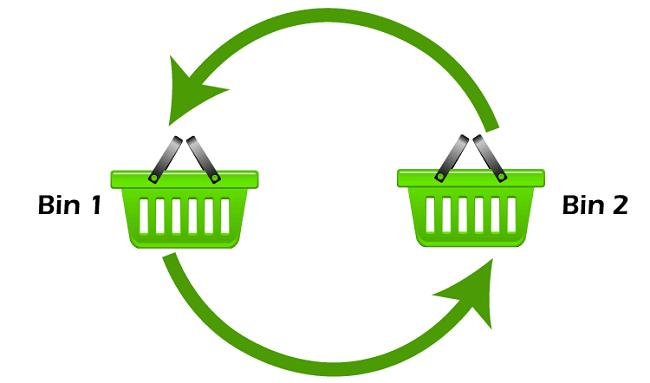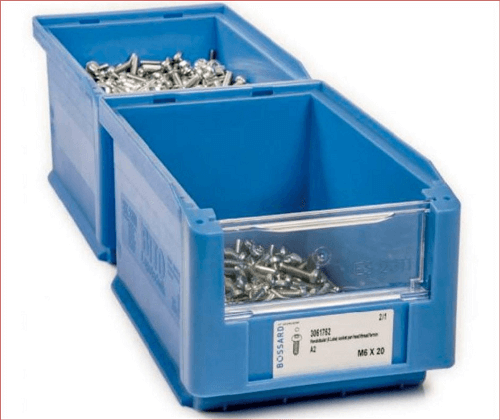Two-Bin Inventory ControlAs the name indicates, the two-bin inventory control approach uses two identical bins that are used alternately. Both of them contain materials that are included in the finished product. The first bin will be used in production until it is empty. Then, after the first one is completely exhausted, the need to use the second bin will begin. The empty one will serve as a reminder to restock. As a result, the production line doesn't halt to get the necessary components. 
In simple terms, a two-bin inventory control system is utilized when goods or materials employed in production need to be restored or refilled. A limited quantity of working stock is maintained in the first bin, and reserve stock or extra material is stored in the second bin. The second bin should be stocked with enough goods to maintain until the first bin's order comes in. A refill or replacement order is placed when the first bin's contents are finished. The second bin's contents are consumed while the first bin's order is awaited. The quantity of goods in the reserve stock bin equals the quantity the business anticipates using during the ordering lead time connected to that item. To use this technique, one should place a new order as quickly as the working stock bin runs out, allowing fresh parts to be retrieved back before the reserve stock bin runs out. The just-in-time (JIT) production method is closely related to the two-bin inventory control technique, also occasionally referred to as Kanban. Two-bin inventory control is usually always used for small or low-value commodities that are simple to buy in bulk and store. Bin cards and store ledger cards are used to keep track of the inventory. The two-bin inventory control method helps businesses to minimize inventory risks and consistently have the proper amount of stock to satisfy demand. The Working of Two-Bin Inventory Control
One of the major problems businesses have is effectively managing inventory levels. Lack of inventory can cause businesses to lose out to rivals and miss out on sales opportunities. On the other hand, keeping excessive stock raises the risk of damages, wastage, loss, and falling prey to changes in demand. Additionally, it results in increased storage costs and delays in getting money back from acquired items to reinvest in the company. Therefore, the two-bin inventory control system is utilized. The two-bin inventory control system is a fundamental method used to ensure businesses minimize these risks and maintain roughly the proper amount of stock to satisfy demand without going overboard. In its most basic form, the procedure can be summarised as follows: The 1st bin is positioned in front of or on top of the 2nd bin. At the base of each bin is a reorder card. The first bin, which is easier to reach, is where stock is taken. The 2nd bin is used in place of the first one once emptied. The 1st bin is restocked using the reorder card. The process is repeated when the delivered ordered stock is arranged in the empty bin. This method is widely used in various sectors that conduct manufacturing operations and is also useful for hospital inventory management. Small or low-value commodities that are simple to buy in quantity and easy to store are usually subject to management with two-bin inventory control. Higher-value products, however, are managed by the perpetual inventory system. Moreover, the quantity ordered for bin 2 can be modified following past trends of variation in the rate of depletion of bin 1. The fresh order must be placed once the 1st bin is emptied and reached before the 2nd bin is emptied for the procedure to function as intended. FIFO (First in, First out) inventory management is employed for the two bins since the material stored in the initial bin also serves as the inventory sold first. ExampleSuppose a small firm called 'Company A' uses a variety of nuts and bolts to put its products together. Among the various things it buys coming from external vendors are fasteners. With a lead time, or the duration between the start and end of a production process, is around 3 days on average, it consumes about 1,400 of them in a week or 200 per day. 
Thus, the stock bin must be supplied with at least 600 fasteners per day. Also, the reserve bin at firm A should contain at least 600 fasteners, based on the initial calculation above. The management may decide to add extra fasteners to its 2nd bin as a preventive measure, but it must also be noted that consumption levels can occasionally fluctuate up to 20%. If demand increases and production rates rise, as has occurred in the past, this safety stock may be useful. Advantages of Two-Bin Inventory ControlNumerous firms implement it in one or more processes due to its advantages. The benefits or advantages of the two-bin inventory control system are listed below:
Limitations of the Two-Bin Inventory ControlIn retrospect, there is a cost associated with these advantages. The purchasing choices get complicated when there is a sharp increase in demand. Keeping additional inventory on hand all the time could inevitably increase carrying costs. This may sometimes result in a significant increase in the overall investment made and also tolls cash flows when combined with the purchase price of the additional warehouse area. Some steps to get around these limitations are:
The disadvantages can be somewhat avoided; however, they cannot be entirely ignored. Therefore, instead of concentrating on completely removing issues, one should attempt to increase the usefulness of the entire system. Sectors where Two Bin Inventory can be usedGenerally, the Two Bin Kanban technique is best used in businesses that operate in high quantities. Such businesses require goods with better interoperability because employing the same parts in multiple products can accelerate their operating process. All of the typical components point to the requirement for a marketplace that quickly consumes completed items. With this approach, most of these goods are perfect for bundling because they're usually categorized as less expensive, replaceable, and easily accessible. Following are some of the areas where the two-bin approach is widely used:
Next TopicHow to Achieve Optimal Asset Allocation
|
 For Videos Join Our Youtube Channel: Join Now
For Videos Join Our Youtube Channel: Join Now
Feedback
- Send your Feedback to [email protected]
Help Others, Please Share









